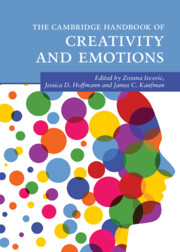Book contents
- The Cambridge Handbook of Creativity and Emotions
- Cambridge Handbooks in Psychology
- The Cambridge Handbook of Creativity and Emotions
- Copyright page
- Dedications
- Contents
- Figures
- Tables
- Contributors
- Acknowledgments
- Creativity and Emotions
- Part I Methods in the Study of Creativity and Emotions
- Part II The Development of Creativity
- Part III Emotions and the Creative Person
- Part IV Emotions and Creative Products
- 17 Emotional Creativity
- 18 Affective Factors in Dark Creativity
- 19 For Emotion’s Sake … The Centrality of Emotions in the Art Experience
- 20 The Affective Benefits of Creative Activities
- 21 Everyday Creativity as a Pathway to Meaning and Well-Being
- 22 Creative Arts Therapies
- 23 Developing Emotion Abilities through Engagement with the Arts
- Part V Emotions and Creativity at School and Work
- Index
- References
22 - Creative Arts Therapies
Processes and Outcomes for Emotional Well-Being
from Part IV - Emotions and Creative Products
Published online by Cambridge University Press: 16 February 2023
- The Cambridge Handbook of Creativity and Emotions
- Cambridge Handbooks in Psychology
- The Cambridge Handbook of Creativity and Emotions
- Copyright page
- Dedications
- Contents
- Figures
- Tables
- Contributors
- Acknowledgments
- Creativity and Emotions
- Part I Methods in the Study of Creativity and Emotions
- Part II The Development of Creativity
- Part III Emotions and the Creative Person
- Part IV Emotions and Creative Products
- 17 Emotional Creativity
- 18 Affective Factors in Dark Creativity
- 19 For Emotion’s Sake … The Centrality of Emotions in the Art Experience
- 20 The Affective Benefits of Creative Activities
- 21 Everyday Creativity as a Pathway to Meaning and Well-Being
- 22 Creative Arts Therapies
- 23 Developing Emotion Abilities through Engagement with the Arts
- Part V Emotions and Creativity at School and Work
- Index
- References
Summary
The Creative Arts Therapies (CAT) is an umbrella term covering several specialized disciplines: art therapy, dance movement therapy, drama therapy, psychodrama, music therapy, and poetry / bibliotherapy. In these healthcare professions, arts-based creative and expressive processes and their products are used to improve health and well-being within a therapeutic relationship. The first part of this chapter will provide an overview of the CAT disciplines, training requirements, and the field’s history. The second part will describe the therapeutic change factors shared by all CAT disciplines. Part three will discuss evidence-based findings from CAT studies on emotional well-being including regulating and processing emotions, stress relief, depressive symptoms and grief processing. Finally, in part four, future directions for CAT research will be suggested, with an emphasis on change process research, including mechanisms of change.
Keywords
- Type
- Chapter
- Information
- The Cambridge Handbook of Creativity and Emotions , pp. 411 - 433Publisher: Cambridge University PressPrint publication year: 2023
References
- 1
- Cited by



